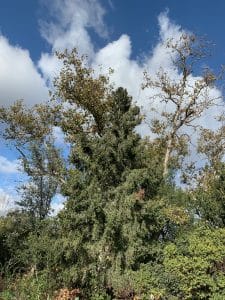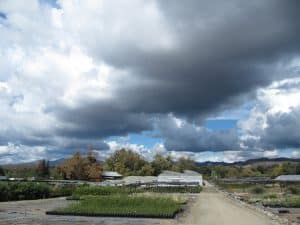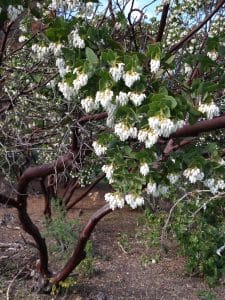According to our proposed “six-season calendar for natural gardening,” we are officially entering winter. Our gardens have settled into their quiet time when rain and wind refresh, the sun’s low arc across the sky provides light but not much heat, and plants start their preparations for spring, because they (like good gardeners) live both in the moment and into the next season.
Winter – December, January – enjoy the short days, migratory birds, bundle up, pray for rain.
Spring – February, March, April – enjoy abundant flowers, birds, butterflies, life!, good planting season.
Pre-Summer – May – Bye bye cool and moist, hello hot and dry, transition month.
Summer – June, July, August – enjoy the long days, judicious watering, summer bloom.
Pre-Fall – September – Bye bye hot and dry, hello cool and moist, transition month.
Fall – October, November – many garden tasks, planting season begins, fall flowers.
History and review
Though last month was very dry, we’ve had a couple good rains that soaked the ground late November and earlier this month. Observe: when we get 1-2” of winter rain falling over a 2-3 day period, this is our model for deep soak irrigation in summer. All the water truly soaks in, but more importantly, air (roots need oxygen too) always follows the water down into the root zone between those wonderful showers. Log this memory away as next summer you will need to recall how this works.
Watering
None. Natural gardens thrive on rainfall alone, unless we have another super dry winter, in which case you may have to provide a deep soak, not to just keep your plants alive, but more in order to help them get ready for spring.
Related to Watering
If you are tending to the needs of plants you recently planted, i.e.; last fall, be sure to keep an eye on the nursery root ball. If we have any dry winter weather, the potting mix in the nursery root ball may dry out at a different rate than your surrounding soil. Of course you want to encourage an eventually extensive root system by coaxing new roots out of the nursery root ball into your native soil with adequate moisture levels. If you need to water the root ball only, use a watering can or a hose to fill the planting basin, without watering the whole garden.
Pruning
Feel free to continue where you left off last month. Shape plants knowing that spring will arrive in its own time. If semi-woody plants like buckwheat, sunflower, sage, and sagebrush are crowding each other or growing over one another, trim each one back into its own space, its own shape, always remembering that in a couple months the days and the soil will turn warmer and everything will start to grow again.
Weeding
Cool season weeds are germinating. Pull them or use a hoe to get rid of them as soon as possible. Easier to eradicate them when they are small.
 Mulching/Top dress
Mulching/Top dress
Deciduous trees, even non-native types are turning color and their leaves are falling every day. This valuable natural “mulch” or top dress is obviously under appreciated by clean up crews who rake and blow the leaves into big piles to be hauled off as green waste, meantime purchasing “mulch” of questionable quality (from green waste) to be placed onto the bare earth they just raked clean. Ironic. I’ll bet you can find a natural solution to the “problem” of fallen leaves and bare earth.
Feeding
Soils are dipping into their coldest temperatures in winter. If you applied fertilizer last fall, you’re set. If not, best to wait until early spring.
Troubleshooting – Varmints, Pests and Diseases
Many plants have tender shoots and lots of new growth this month, with more to follow. Watch your manzanita plants, as the new leaves on branch tips are susceptible to a serious insect pest called manzanita leaf-gall aphid. You’ll know it when you see it. The plant reacts to the aphid infestation by forming brightly colored (magenta) gauls on the leaves, causing unsightly distorted branch tips, and severely stunting the growth for the season. The remedy is to cut the damaged tips off and discard them away from the garden. To prevent further damage and kill any remaining aphids inside their protective leaf galls, only a systemic insecticide will work. That said, you should not spray any plants that have blooms on them, as this can negatively affect pollinators. If you prefer to not use chemical pesticides, you will have to be extra diligent by removing every leaf that shows gall damage. Some years are worse than others, so be diligent, and we’ll see how this particular winter/spring racks up to previous years. It seems that ground cover varieties are more vulnerable.
Annual Wildflowers
Since winter was delayed by a basically dry November, you can still sow wildflower seed mixes this month. Come on over, we have several to choose from.
Adding New Plants
Winter gardening is easy and fun. Take your time, dig the best hole you can for each plant, and enjoy the experience. Winter is also a good time for transplanting or moving plants around in the garden, as plans change, plants outgrow their space, or you get a new vision for a certain spot in your garden. For large plants, you can do it in stages. Step 1: Dig a trench around the root ball you intend to lift out of the ground, and leave the plant in place for a couple weeks with all the side roots cut. Step 2: Undercut the root ball and lift it out of the hole, or leave it in the hole a couple more weeks, now with all the roots severed. Step 3: The receiving hole having been pre-dug, carefully transport the plant with soil root ball intact and plant it in its new place. In preparation for this procedure, tag the plant so you do not change its orientation to the sun’s pattern. You can trim the branches in proportion to the roots you are cutting,  especially on semi-woody plants like sage.
especially on semi-woody plants like sage.
Engage
Photography, sketching, journaling, reading, walking, meditating… or a combination of these activities will help keep you in the moment while you also explore thoughts about the next. Since garden “chores” are winding down and winter weather is busy promoting new growth and new life, I hope you will find inspiration on some back road or hiking trail. December full moon falls on winter solstice this year, so our longest night might provide sufficient light (depending on cloud cover) for some unforgettable outdoor activity, sketching by moonlight, journaling in the dark, or walking in the cold. Or maybe just a quiet moment around sunset in your quiet garden, on the quietest day of the year.
Season’s Greetings, Merry Christmas, and Happy New Year!
From the Garden,
Mike Evans
Questions? Help is just one call or one email away. Call (949) 728-0685 or email (with pictures if you like) our special helpline: gardenhelp@californianativeplants.com